Sorry, I cant find this one.
Category: Best Visual Effects
1944 – The Adventures of Mark Twain




The Adventures of Mark Twain – 1944

At least this wasn’t another war propaganda film! It seemed that was all they were making in the 1940s. Special effects from the era seemed to be an endless barrage of stunt flying, naval battles, and explosions. But here, we are treated to a biopic of one of the most beloved American authors of the nineteenth century.
Now, that being said, we have another case of a movie with very little to speak of in the way of special effects. We have the standard store of rear-projection shots, sea water flowing by in the background and the like, and a couple composite shots that were cleverly constructed. There were a number of layered image montages to show the passage of time, or panning across a globe to depict travel to different locations. But on the whole, there just weren’t many visually interesting or innovative special effects.
There were a few sequences that stood out, but just barely. For example, near the beginning of the film, there is a shot of Tom Sawyer, Huckleberry Finn, Jim, and young Samuel Clemens himself, on a raft, struggling in the wake of a great steamboat. The shoddy raft breaks apart in the rough waters and the boys fall into the water. The steamboat appeared to be a scale model in these shots, and I’ll admit that they were pretty convincing.
And then there was another interesting sequence in the film, when an exhausted Twain dreams that miniature versions of some of his characters are walking on his desk, and reading his unfinished manuscript. But even here, the effect had been done before, and there was nothing that looked too difficult for 1943 filmmakers.
And finally, there was the ending sequence in which Twain dies. Through the use of selective lighting, images of Tom Sawyer and Huck Finn appear behind the author’s death bed to lead his ghost into a glorious sunset. It was a clever composite shot that combined several images that appeared in stages, as the deceased Twain and his grieving daughter fade into mist. As the trio walk away from the camera, I think the actors are seamlessly replaced with animated figures who disappear over a distant hill, though I could be mistaken about this one.
There were a couple of other noteworthy effects. For example, according to an article by Frank Miller on the TMC website, “The special effects department also aided in the dramatization of Twain’s story, ‘The Celebrated Jumping Frog of Calaveras County,’ and created animated versions of Tom Sawyer and Huckleberry Finn, all of which helped the film score an Oscar nomination for Best Special Effects.” But I also suspect that the makeup that, over the course of the movie, aged Frederick March seventy-five years may have been a factor, as Best Makeup didn’t officially become a category until 1981.
1943 – Stand By for Action




1943 – Stand By for Action

I’m having difficulty separating this movie’s overall quality from the caliber of its special effects. Not that I’m trying to make excuses for the film, but it was MGM’s first attempt at a naval war film. The story was just so… so bad. There I said it. The effects themselves, which were a product of the story, were passable, but just barely.
There simply weren’t that many special effects. In an era in which almost every movie that was being made was a war propaganda film, it tried to follow suit with a story that combined The Little Engine That Could with the concept that even old-timers can kick butt with the rest of them. The film was ten minutes shy of two hours. The first forty-five minutes is filled with bad acting and characters that were not likeable, all trying unsuccessfully to get the audience to care about them. There was almost no action, and a few poor rear-projection shots.
Then there was a little sequence in which a Japanese scout plane targets the old ship, the Warren, and drops a few bombs, missing with every shot. But the plane looked like a toy model, and it moved unnaturally through the air, almost as if the toy was strung up on wires, and moved by a clunky crane from off-camera. That being said, I doubt that was how the illusion of the flying plane was accomplished, but either way, the effect just looked really cheap.
After that, we are given one of the movie’s more interesting sequences in which the old ship is asked to power its way through a storm and some choppy waters at high speed. The scale model work was ok, and a few of the wide shots showing the boat crashing through the waves were alright . In this short sequence, we see a few stunt men being tossed around the watery deck, one of whom is almost washed overboard.
But then we are bogged down in ridiculous story that had me rolling my eyes, lasting for another forty minutes. The movie wantonly broke my cardinal rule of movie-making which says that cute for the sake of cute is never cute. Never. The crew rescues a rowboat full of pregnant women and crying babies. No action, just naval officers worrying about women giving birth on board the ship, like expectant fathers in a hospital waiting room, and naked infants crawling around the deck of the war vessel.
Finally in the last ten minutes, there is a naval battle which largely consisted of the Warren creating a smoke screen and playing a slow game of hide and seek with the Japanese battleship. Eventually it came out right in front of them and blew them out of the water in a giant ball of flames, and that was it. Sorry, but when it came to the special effects, this was a case of too little, too late.
1943 – The North Star




The North Star – 1943

The special effects for The North Star were nearly perfect. That is to say, they were used perfectly. I was completely surprised by the heavy emotional content of the film, that of a peaceful Russian village, when the Nazis attack. The first half-hour of the film is devoted to character development. When the visual effects began, they only there to enhance the emotional drama of the characters.
When the Nazis attack, the lives of the gentle villagers are torn into bloody ruins. Usually filmmakers used bombs as a visually shocking effect. They cause a lot of damage, and the sight of exploding shells are big and flashy on the screen. But this film was unique in that the effects concentrated more on machinegun fire.
We are shown barrages of rapid-fire bullets dotting the ground, the buildings, and even the people. We see horses and riders crashing to the ground as the tiny projectiles mow them down. The effects artists really did a phenomenal job of setting up charges in the walls that exploded into little bullet holes as the composited airplanes flew overhead.
There was one fantastic shot in the attack, where a Nazi plane is flying over a bridge, firing its guns at a horse and cart. We can actually see the severe lines of the deadly bullets as they streak through the air, and we see the little eruptions in the water as they disrupt its surface. It was an awesome shot! And to the movie’s credit, they didn’t shy away from showing blood, even the blood of murdered children. The effect packed an emotional wallop for the little propaganda film.
Then there was the final climactic battle scene, as the men of the village return and attack the Nazis. They set the lake, and several enemy soldiers, on fire before charging in on horseback like the charge of the light brigade! Unfortunately, they tried using a trick that rarely works for me. There were a few shots where they sped the film up to make the action seem faster and more intense. The problem is that any time that effect is used, it just looks so different from the rest of the action, that it stands out like a sore thumb.
And there was one other tiny little effect that caught my attention. At one point, in the first part of the movie, they were trying to create a mood that would contrast the coming chaos and carnage. As a group of youngsters are traveling to Kiev, they bed down by the side of the road. We are given a shot of a bird on a branch, silhouetted against the night sky. It was clearly a hand drawn animation. However, it stood out, and not necessarily in a good way. It looked very much like a cartoon. I wouldn’t usually like such an obvious effect, but I’ll give this one a pass. It was short, sweet, and innocuous, and it had the proper effect of enhancing the emotional mood of the moment. Just don’t do it again, Louis Milestone.
1943 – Crash Dive (WINNER)




Crash Dive – 1943

The special effects for Crash Dive were top-notch. Not only did they make great use of actual military watercraft, they also had some excellent scale models that allowed for some wonderful effects of massive destruction. At first I thought the film was going to be all about the creepy stalker romance, and a lot of it was. But literally, the last twenty-eight minutes of the one hour and forty-five minute film was devoted to a dangerous and daring military action at a secret Nazi supply base on an island in the ocean.
The film started us out with a great little sequence in which a number of awesome PT boats mount a mission to rescue American crash survivors floating on a raft at sea. They have to defend themselves from a German sub, which the PT boats destroy with apparent ease by dropping depth charges into the water.
But then the movie is dominated by a romantic plot in which Tyrone Power relentlessly and forcefully pursues a woman who begs and pleads with him to leave her alone, just like in The 1942 Best Special Effects nominee, The Black Swan. Fortunately, it is broken up by a really cool action sequence, in which the American submarine, the Corsair, does battle with a German Q-ship. The Q-ship is a heavily armed merchant ship with concealed weaponry, designed to lure submarines into making surface attacks. But after our heroes outsmart the pesky Nazis, we went right back to the ridiculous romance.
But then the plot took a complete left turn and left the love triangle in the dust. The special effects and action in the second half of the movie made up for the slow first half. There were some great shots of the Corsair playing cat and mouse with Nazi vessels, ghosting their trajectories through an underwater minefield. Then after they make it into the base’s waters, a daring land raid, led by Tyrone Power, is carried out to place explosives all over the Nazi installation.
Buildings begin exploding, tommy-guns begin firing, flames begin raining down from the sky, and Nazis begin dying! The American soldiers make a harrowing dash back to the water as the island base erupts in fire and chaos! The Corsair clears the way for their escape, firing torpedoes and disabling the enemy ships. There was even a really cool shot of a Nazi mortar as it hits the Corsair, destroying the periscope. The sub was able to stay afloat, but could no longer dive. Our other hero, played by Dana Andrews, had to remain on the outside to guide the sub as it submerged just enough to avoid being seen by the Nazi soldiers, but not so far that he would be drowned.
It was an exciting sequence that was excellently filmed! The stuntmen and the pyrotechnic technicians really had their work cut out for them and they came through with flying colors. It was an action sequence that was worthy to stand in the company of any other great war movie like The Guns of Navarone or The Dirty Dozen, all very intense dramatized action films with some great special effects!
1942 – The Navy Comes Through
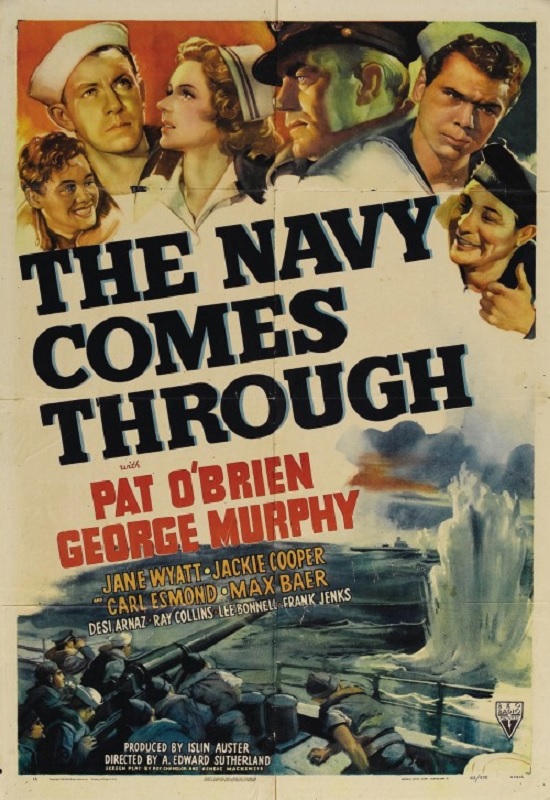
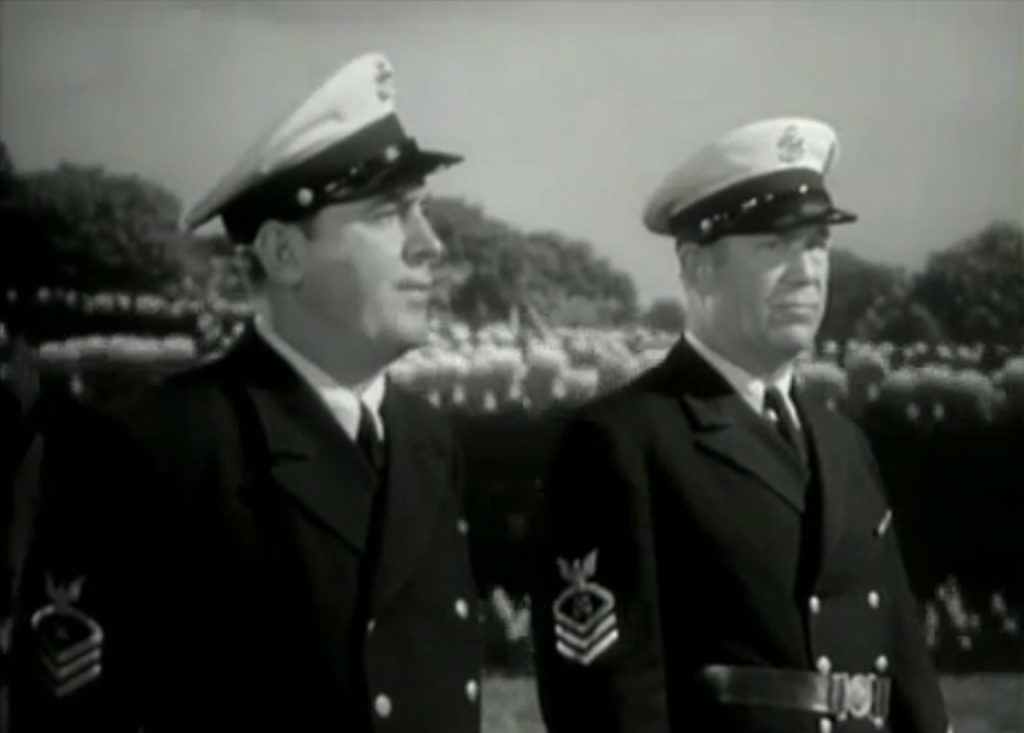
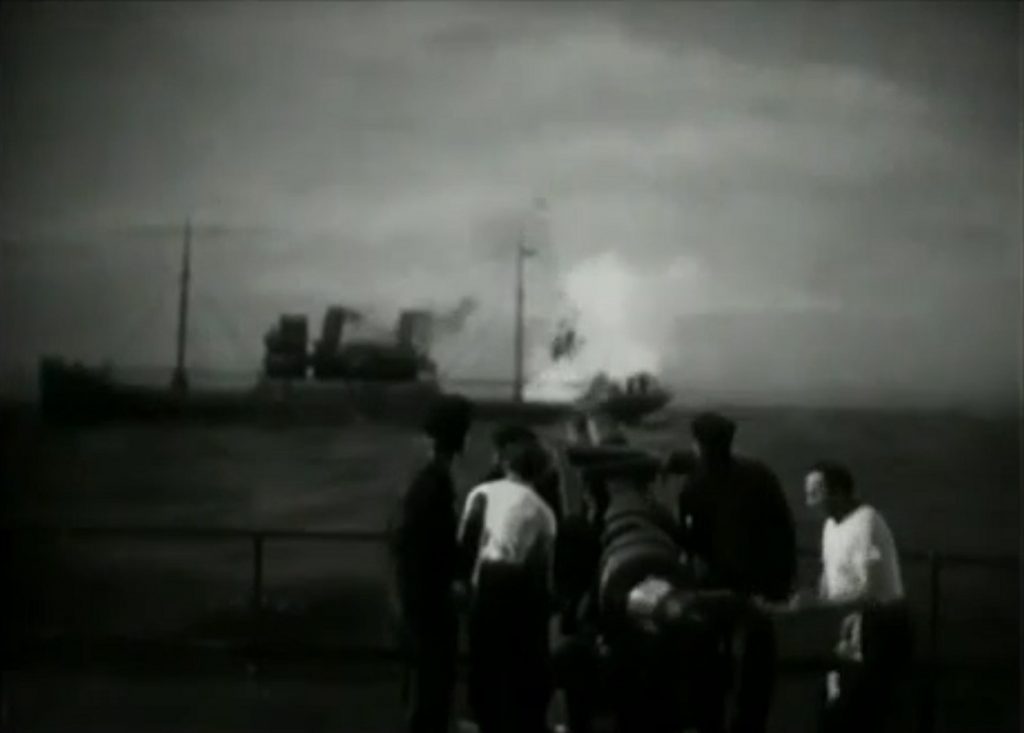
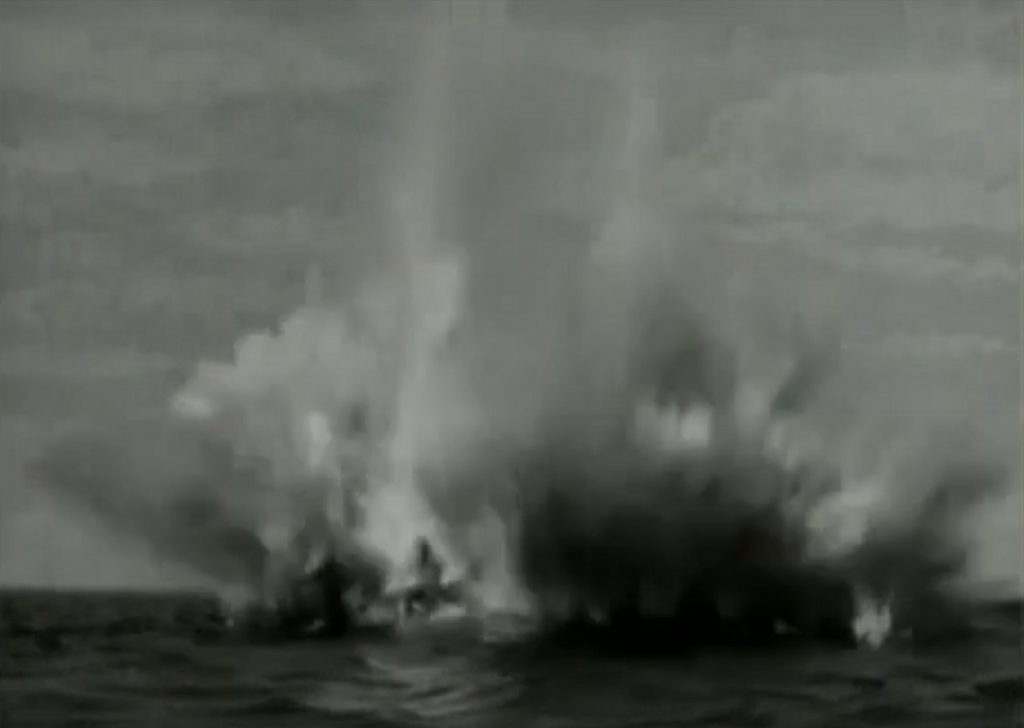

1942 – The Navy Comes Through
I have to say, I wasn’t terribly impressed with the visual effects for this movie. Sure there were a couple of explosions, but not much to write home about. At least the biggest and best one was in the climax of the movie, where the enemy submarine explodes from the inside. But honestly, that was about it. The rest of the effects weren’t that good.
You’d think the simplest effect would have been rear projection shots, but the ones that caught my attention looked pretty bad. Even a shot so ordinary as two men standing on the parade ground in front of marching soldiers looked to be poorly constructed. The men in the foreground were in perfect focus, and the background was so completely out of focus, that it was obvious that they were not part of the same image. They looked separate, like they didn’t belong in the shot.
Maybe it was the lighting, but they looked like they were standing in front of a badly-done green screen. As a matter of fact, a little bit of research told me that green-screen technology was actually developed in the 1930s, and used a little in the 40s. But it wasn’t until the 1970s and 80s that the technology was good enough to be used widely in films.
But for me, that was just an obviously bad visual effect that I noticed in more than one shot. Most of the other effects in the movie were just fine. Nothing out of the ordinary, but nothing else as strangely bad as the rear-projection shots. As I mentioned before, there were some perfectly competent explosions, and a scene or two that had some water being blown onto the deck of a ship, soaking the soldiers trying to do their jobs. There was even a great scene where an officer was unconscious in a room that was on fire, and another man has to rescue him. That was actually a pivotal scene in the narrative, and it was handled pretty well.
There were also some pretty ordinary shots of things like falling debris, or a submarine diving beneath the water, an illusion for that worked. I couldn’t tell if it was a real submarine crash diving or a model. Either way, it looked fine. There was also a fairly memorable scene where our heroes are hiding from the enemy vessels in the fog, but again, that seems like it would be a pretty simple effect, nothing to get too excited for. I don’t know, it just seems like I have seen the effects that were done well in other movies, and done better. I am not exactly sure why the critics of the time gave the visual effects such high praise.
Maybe I’m missing something, or maybe I’m just showing off my own ignorance. But I expect better from an Oscar nominated film. I don’t need my socks blown off, but I do need to not be taken out of the story because of a background that looks fake, especially when it didn’t have to be. But for all that, maybe I’m just expecting too much. But as uneducated as I am, I do know that other movies in the same era did the same things, but better. I’m glad it didn’t win the Oscar.
1942 – Reap the Wild Wind (WINNER)




Reap the Wild Wind – 1942 (WINNER)

The Special effects of this movie weren’t perfect, but they were pretty darn close. They were consistently good throughout the entire film. Everything from the rear-projection shots to the scale models, the animatronics to the stop action animation, and the matte paintings to the image compositing, was good across the board.
The film had the prerequisite romance story that most movies of the era had, but it also had an element of adventure and intrigue. Aside from the love triangle, the main conflict of the narrative was two murderous brothers who would cause ships to crash against the rocks of the Florida Keys, then appear to rescue their cargo for fifty percent of the profits. As such, much of the action took place on mercantile vessels in the 1840s. Rough seas, wind, and spray, were combined seamlessly with wisely used rear-projected ocean waves.
The shots were perfectly put together. I mean, the backgrounds were clearly artificial, but the lighting and the camera angles were wonderfully thought out and executed to come as close to reality as possible. There was one shot in particular that caught my attention as well done. The projected image was of a ship firing a canon at another vessel. The actors were on a set of the deck of the ship being attacked. We hear the canon and see the smoke, and then there was a small impact in the water behind the actors and the are sprayed with water. So simple, and yet the two images were blended very believably.
There were some great scale models of ships both before and after their sinking that were perfectly believable. The only thing that detracted from those shots was the strange effect that the close-up filming of water always has. Liquid doesn’t move the same in normal and close-up filming. It is always an obvious effect.
But it was the film’s climax that was the real star of the show. First of all, it took place underwater! That alone made it stand out from most other contemporary special effects. But then the two divers encounter a giant squid. Of course, suspension of disbelief was a necessity, but only because realistically, giant squid don’t hang out so close to the surface of the water to take residence in sunken ships. But hey, it made for an interesting monster in an exciting sequence.
The whole mechanical squid was a great and exciting effect that was really cool to watch. But in particular it was the first time I have seen stop-motion animation used in a film that was nominated for Best Special Effects. That isn’t to say such effects had never been done in movies before. Far from it, but it made for a sweet shot as a squid tentacle wrapped itself around a struggling diver.
This was the movie that won the award for Best Special Effects, and comparing it to the other 1942 movies that were nominated, I think it really deserved the honor. The effects were creative, skillfully executed, and really fun to watch, giving audiences some awesome visuals in Technicolor that were fuel for the imagination!
1942 – Pride of the Yankees
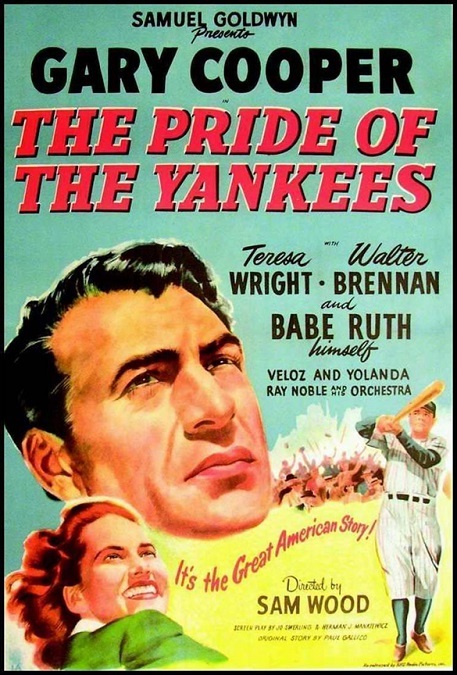
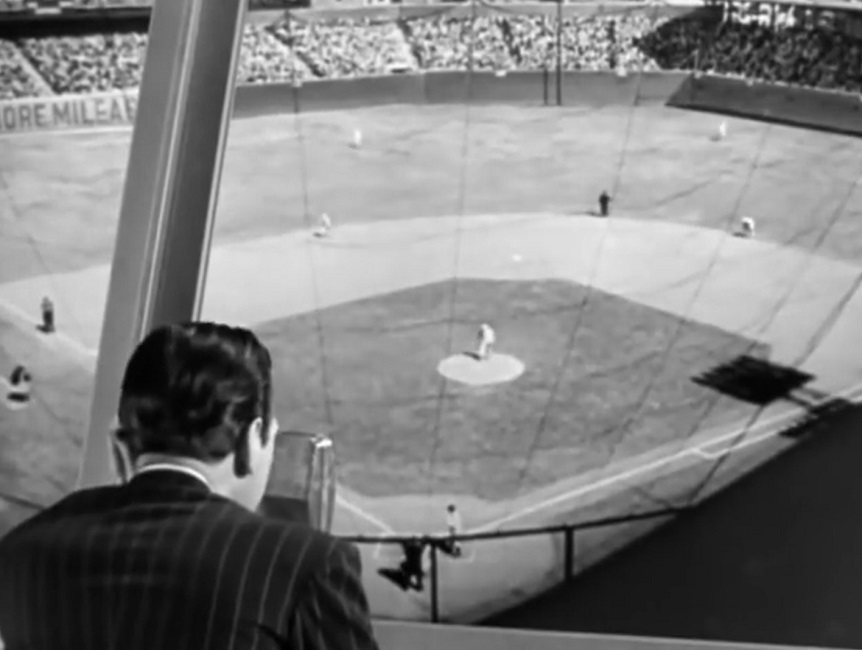
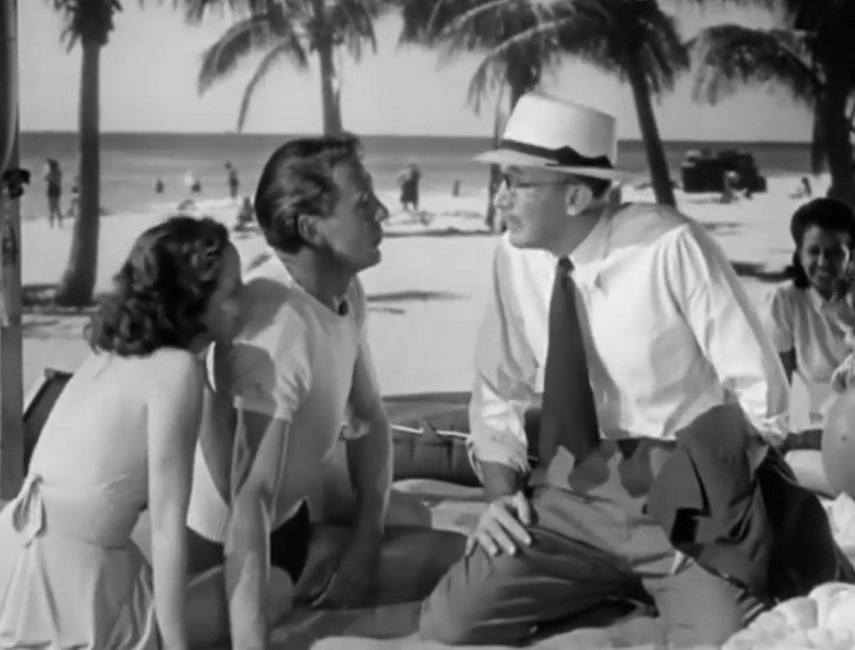
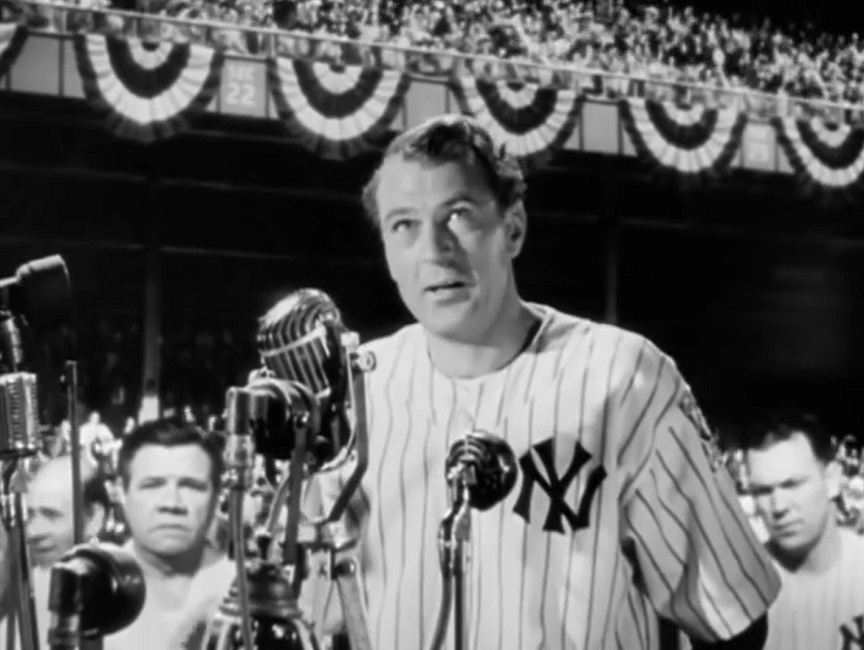
Pride of the Yankees – 1942

Ok, I’m going to be honest. I really can’t figure out why this movie was nominated for Best Special Effects. It had practically no special effects in it. It had a bit of rear-projection and a couple of matte paintings, but there was very little of even those illusions. The sound? It was nothing special. So why was it put on the list? What am I missing?
Well, I did my research. I searched the internet, read reviews, articles, and film award summaries. Nothing I found gave a good reason as to why the movie was even considered for this particular award. In all that I read, I can only find a few weak reasons why the film’s special effects were recognized, and I’m not even sure they were the real ones.
First there was the lighting effects that were used to de-age Gary Cooper for the earlier scenes in the movie. According to Wikipedia, Cinematographer, Rudolph Mate, “lighted Cooper from below during those early scenes to conceal lines and wrinkles, then gradually reduced and finally eliminated the lighting effect as the story progressed.” But would you really call this a special effect, or was it just clever cinematography?
Second, I learned that Gary Cooper was right handed, while Lou Gehrig was a famous lefty. For the scenes showing Cooper at bat, it wasn’t a problem. The actor learned to bat left-handed. But throwing the ball was a different matter. That is a much harder motion for a right handed person to pull off. There were two different methods they use to achieve the illusion. For some of the wide shots, they used another actor as a stand-in. In a few of the closer shots, they had Cooper wear an inverted jersey, then reversed the film direction, making it appear that he was throwing left-handed.
The only other special effect I can find in the movie was the final scene… I think. I can find no actual evidence on the internet for this one, and it is just a guess on my part. I’ll fully admit that I might be mistaken. During Gehrig’s “luckiest man” speech at the end of the film, I suspect that Cooper might have been inserted into actual newsreel footage from the event. It was clearly like a rear-projection shot. The actor’s image is really sharp, while the background image, which included Babe Ruth and a few other ball-players, was really out of focus, like dated newsreel footage. However, Babe Ruth was actually used as an actor in the film to play himself, so I could be mistaken. But even if I am right, it was just a simple rear-projection shot.
Either way, I just don’t get it. Maybe it was another example of the sound effects being part of the special effects category, thus earning the nomination, but I don’t think so. The sound effects were nothing special or out of the ordinary. Again, if someone has any better insight as to why this movie was nominated for Best Special Effects, please comment and let me know!
1942 – One of Our Aircraft is Missing




One of Our Aircraft is Missing – 1942

This movie surprised me in a very good way. Not only was it a really good movie, but the special effects were unlike anything I have ever seen. Innovative? You bet your boots! And I can say that after watching the first few minutes of the film, my expectations weren’t very high.
What I mean is that in the opening sequences, the quality of the film, in general, didn’t seem very good. The sound seemed off, somehow. Whenever any of the actors spoke, their voices sounded too high-pitched and nasal, like a cartoon character. And the picture on the screen looked dark around the edges, almost like some of those really early examples of film from the silent era. Also, there were no big American Hollywood names in the film, implying to me that there was no big American Hollywood money behind the production. The cast wasn’t completely unknown, but there were no superstars like Clarke Gable or Myrna Loy.
But as the opening sequence was drawing to a close, the incredible special effect of an airplane crashing into an electric tower and exploding in a fantastic ball of fire blew me away! My low expectations were proven completely wrong, and over the next hour and a half, I was drawn into a story that was exciting, intense, and incredibly well-told! It was a film that strove for realism and authenticity, and I think it really accomplished its goal. In fact, as a form of sound effect, there was no underscoring in the film, adding to the air of reality.
Many of the visual effects made use of the standard tricks of the trade in the 1940s. Matte paintings, rear-projection, and the like, made the sets and locations seem bigger than studio film lots. It is also important to note that when the production began filming, the script was unfinished, and was constantly being updated during production. Apparently, as new wartime technologies kept being invented, the script would be re-written to include them.
But there was one sequence in particular that caught my attention. The bombing of Stuttgart was incredible. Even now, I’m not sure how some of their effects were accomplished. As the Vickers Wellington Bomber flew over the burning city, anti-aircraft projectiles were hurtling through the sky. The image, on the whole, was fairly dark, but these streams of ephemeral light were streaking through the smoke. They looked like either focused beams of moving light being projected onto the smoke, or animated enemy fire. I’ve never seen such a technique used in film before, and it looked phenomenal!
According to Wikipedia, the Bomber was constructed in Riverside Studios, Hammersmith as a large-scale replica. It filled the entire studio floor and was fitted with lights and explosives for when it got shot down. It was an incredible special effects sequence that completely caught me off guard and surprised me with its innovative techniques and realism. Add to that a well-deserved nomination for Best Original Screenplay, and you have yourself some great film-making!
1942 – Mrs. Miniver
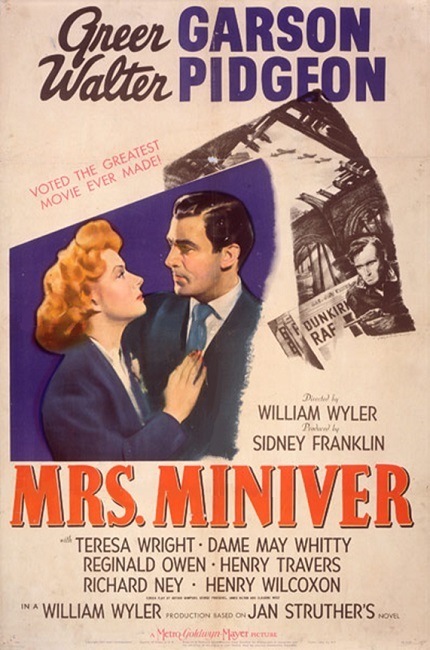
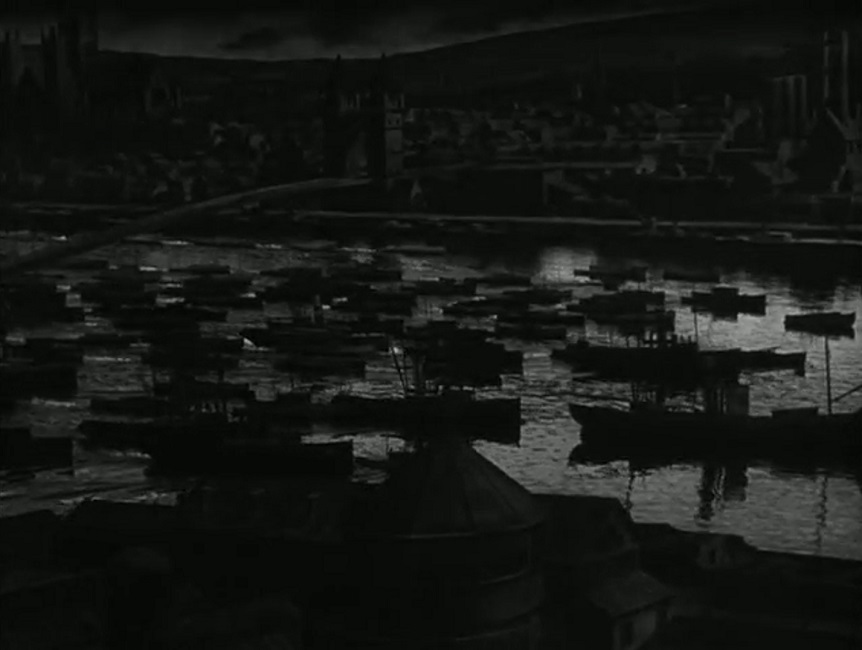


Mrs. Miniver – 1942

Mrs. Miniver may have been a fantastic film, good enough to take home the Best Picture award for 1942. But while I was watching it, I didn’t quite understand why it was nominated for Best Special Effects. But then I remembered… Back in the early 40s, Best Sound was not yet a category. Sound effects were still being lumped in with the visual effects, and a lot of the film’s WWII action took place off screen, leaving the visuals to the viewers’ imaginations.
You see, the movie was not about the war per se, but about a woman’s strength of character as she cares for her family through the hardships of the war. For example, when Mrs. Miniver’s husband leaves to take part in the evacuation of Dunkirk, we see absolutely none of that battle. Instead, we stay with Mrs. Miniver and see her encounter with the wounded German soldier, a great sequence that didn’t require any special visual effects at all.
Another example is during an air raid, when Mrs. Miniver and her family are inside an above-ground bomb shelter. The entire time, the camera stays inside the shelter with the Minivers, and the audience is treated to the sounds of falling bombs, explosions, and gunfire. The only action we actually see is the walls of the shelter shaking a little, and tins of stockpiled food falling from a shelf. The destruction of the family’s house is never shown. That isn’t to say the storytelling wasn’t effective. It was. It just didn’t require award-worthy special effects, though the matte paintings of the destroyed sections of the house looked pretty real.
However, there were two brief scenes in which some visual effects were needed. The first was the scene in which the boats are gathering to go to Dunkirk. We are shown what appear to be dozens of small boats crowding the river. I believe these shots were composites of several groups of boats shown against some matte paintings. Compared to other contemporary films, this effect was nothing special.
Then there was the scene in which Mrs. Miniver and her daughter-in-law are in a car, caught beneath an aerial battle. All we see of the dogfight is when one of the planes catches fire and crashes in a giant ball of flames. The shot of the burning airplane flying over the roof of the car was pretty cool, but ultimately, it was over in seconds, and not special enough to warrant a Best Special Effects nomination.
So why was this movie nominated for that particular award? I suspect it was a combination of two things. First, the sound effects, upon which a lot of the film’s action was based, stirred the voters’ imaginations, almost like a radio program, which was still a popular medium at the time. After all, what we can’t see is often more intense than what we can. And second, Mrs. Miniver was such a wonderful and popular film that it was nominated for twelve Academy Awards. Academy voters loved it so much, they just nominated it for everything they could think of. Fortunately, it wasn’t one of the movie’s six Oscar wins. I don’t know. Maybe I’m missing something here…